 |
| Fig. 1 |
Franz Kröger
Returning Home as a Dead Man
The Bulsa ngarika-burial
Death is a very private affair - not only for the Bulsa. When death is imminent, a Bulsa strives to die in his traditional native compound surrounded by members of his nuclear family. Likewise the subsequent burial (guka) - usually in the night following his or her death - is carried out without any spectators or visitors. For an anthropologist who is interested in Bulsa rites de passage, the investigation into death, burial and the accompanying rituals are among the most difficult matters to research. It is not only the privacy of the mourning family that should be respected, but contact with the dead body, either by touching it or breathing in its peculiar smell (piisim), may pose a great danger for every unauthorized person. All of the “fresh” (yogsik) burials that I saw between 1973 and 2011 were those of my close friends and their relatives. In this setting, I did not primarily play the role of a stranger or European anthropologist but of an associated member of the mourning family (cf. for example my participation in the burial of my friend’s sister, described in Kröger 2012). Being an unrelated friend in this setting is also dangerous because the dead person may try to entice the visitor’s soul (chiik) to follow him or her into the realm of the dead (kpilung). In Wiaga I was advised not even to visit the public funeral celebrations of my late friends Anamogsi and Leander Amoak since they would certainly like me to join them on their journey to kpilung. Although “fresh” burials are principally similar throughout the whole of Bulsaland, there are great differences in how the rites for the deceased are carried out. Age, status and manner of death all play a role in the particulars of the rites. A small baby is buried with fewer rites and at another burial ground (e.g. in the rubbish heap) than an old man (e.g. in his inner courtyard). An old person who died a natural death (i.e. who was called by God) is treated differently ritually from a witch or a person who died by violence or “in the bush” (i.e. outside the traditional compound).
Ngarika Rituals in Achaab Yeri
 |
| Fig. 1 |
In the following I am going to describe the burial of a man named Apung who died and was buried many years ago “in the bush” (sagi po), which means outside of the Bulsa area. For reasons that I will clarify shortly, the man could not receive a traditional burial near his native compound.
When the younger brother of Achaab (name changed), a compound head (yeri nyono) in Wiaga, died in 2004, Achaab had to consult a traditional diviner (baano) quite often. In the divining sessions, it was discovered that the future would bring numerous calamities to Achaab’s family because the burial of Apung, a former inhabitant of the compound, had not been carried out. Apung had left the Bulsa area a long time ago and, according to the results of a divination, had died in Chana (Kasena area). Nobody knew the location of his grave and nobody in Wiaga had seen him in their lifetime.
One afternoon in February 2005, the inhabitants of Achaab Yeri and many neighbours met in front of the compound. The old men, among them the kpagi (most senior elder) of Achaab’s lineage section, were the main officiants of all rituals in Achaab Yeri, and they discussed the coming events of the day in the kusung (meeting room in front of the compound). Most of the women had a chat under a big tree, although a few of them were sitting around the deceased’s rolled-up death mat in the dalong (ancestors’ room, Fig. 1). All were served millet beer (daam).
 |
| Fig. 2 |
In the afternoon a woman, accompanied by some elders, the gravediggers and most other women carried the mat to a footpath toward Chana (Fig. 2) which was, according to the results of a divination, the place of death for the deceased. After some long speeches, one gravedigger unrolled the mat. Usually, if somebody was buried in a foreign town or village, some earth from his grave and a piece of cloth containing his “body-dirt” (daung, e.g. sweat or blood) is kept inside the rolled-up mat. As these things were not available in Apung’s case, they had substituted them with a white cloth provided by Achaab’s people. The gravedigger poured some water on the ground, formed a mud ball from the wet earth (Fig. 3) and wrapped it in the white cloth (Fig. 4).
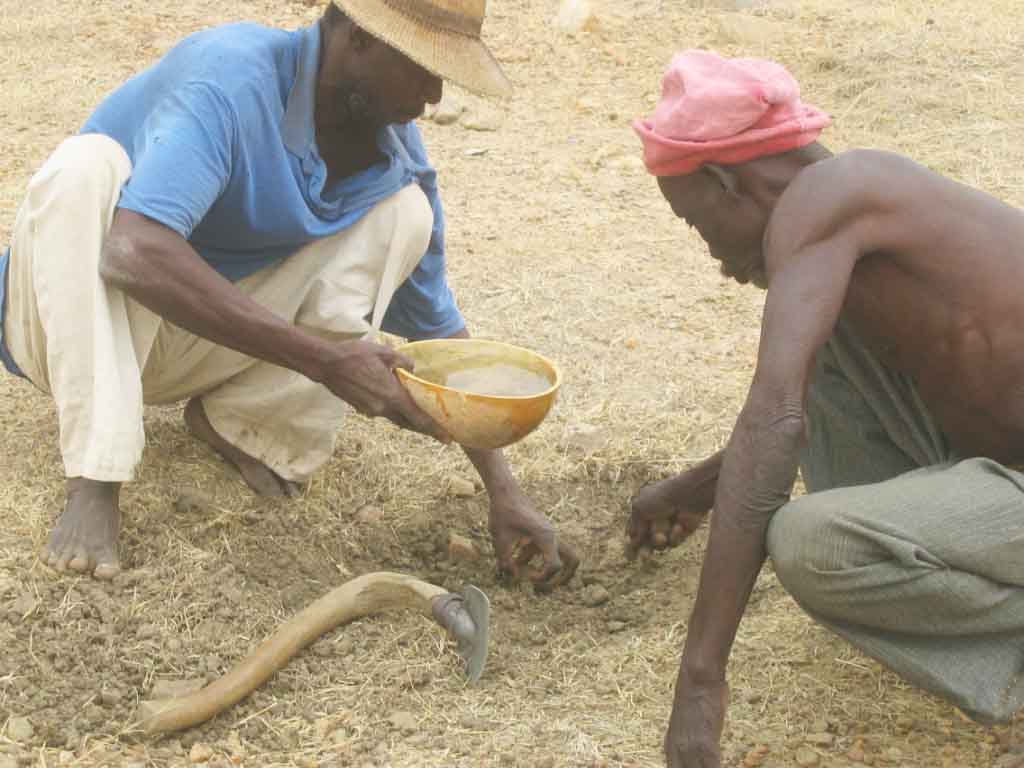 |
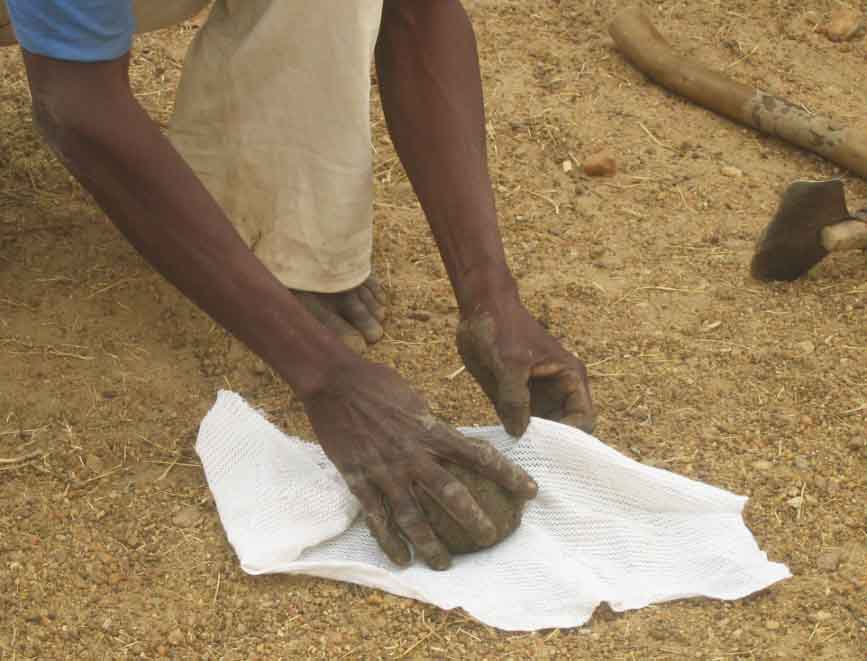 |
| Fig. 3 | Fig. 4 |
The mat, with the mud ball and the cloth in it, was carried to a place near the meeting room (kusung) in front of the compound where the noai-boka ordeal was performed. Usually this ritual is of very great importance and is carried out with a great deal of exertion since it reveals who among the living or dead were guilty of the deceased’s death. Here, however, everybody was sure that the mat would not declare one of those present as guilty or run with the two gravediggers holding it to the house of the culprit since nobody had known Apung while he was living.
Achaab, standing in front of the mat, asked questions which were answered by the mat. If the mat came forward via its carriers, this signified a ‘yes’; if the mat went backwards via its carriers, this signified a ‘no’. At last the kpagi advised Achaab to abridge the procedure. The final result was that no living person had caused Apung’s death (Fig. 5).
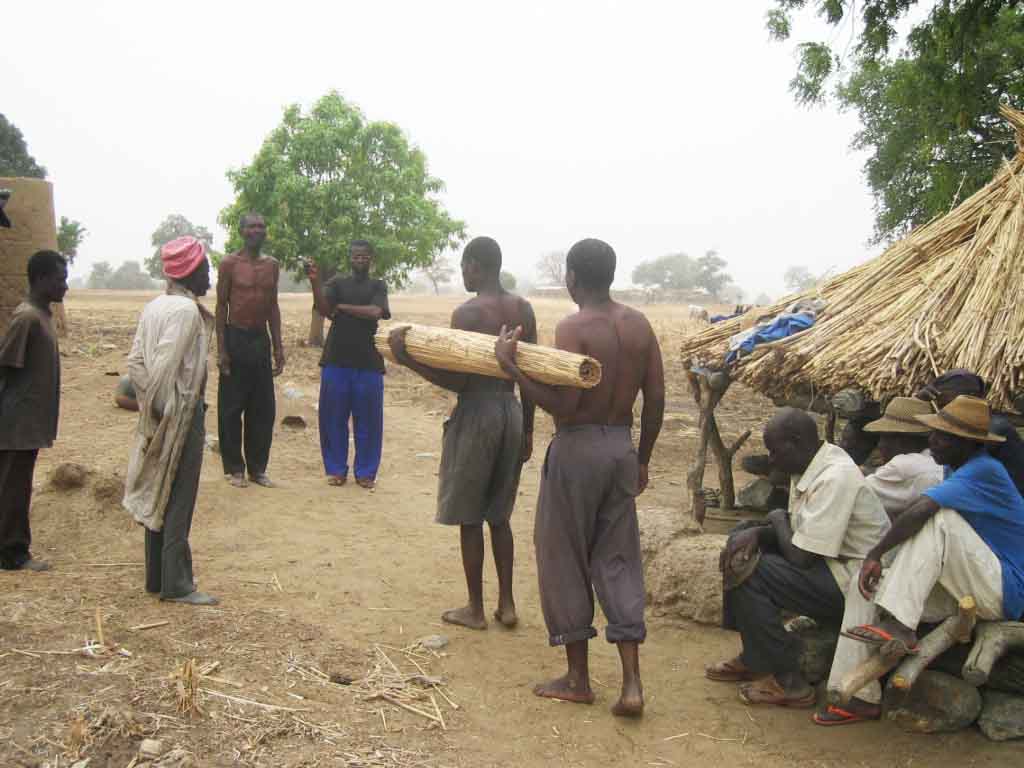 |
 |
 |
| Fig. 5 | Fig. 6 | Fig. 7 |
The mat was carried back to the dalong again, and the general mourning started. Male relatives supported by a male or female friend and women supported by one or two other women – all of them walked towards the mat shedding ample tears and uttering cries of woe, although they were only distantly related to the deceased (Fig. 6). Everybody could see, however, that they were not genuinely affected by the death of a man whom they had never seen in their lifetime. After this formal mourning ritual, they washed their faces with clear water and were cheerful again.
At about 5 p.m. two gravediggers went into the dalong, removed the wet mud ball from the white cloth and formed a human figure out of it. From this point on, the figure was regarded as Apung’s corpse (Fig. 7).
Digging the Grave and Burying the Mud Figure of the Deceased
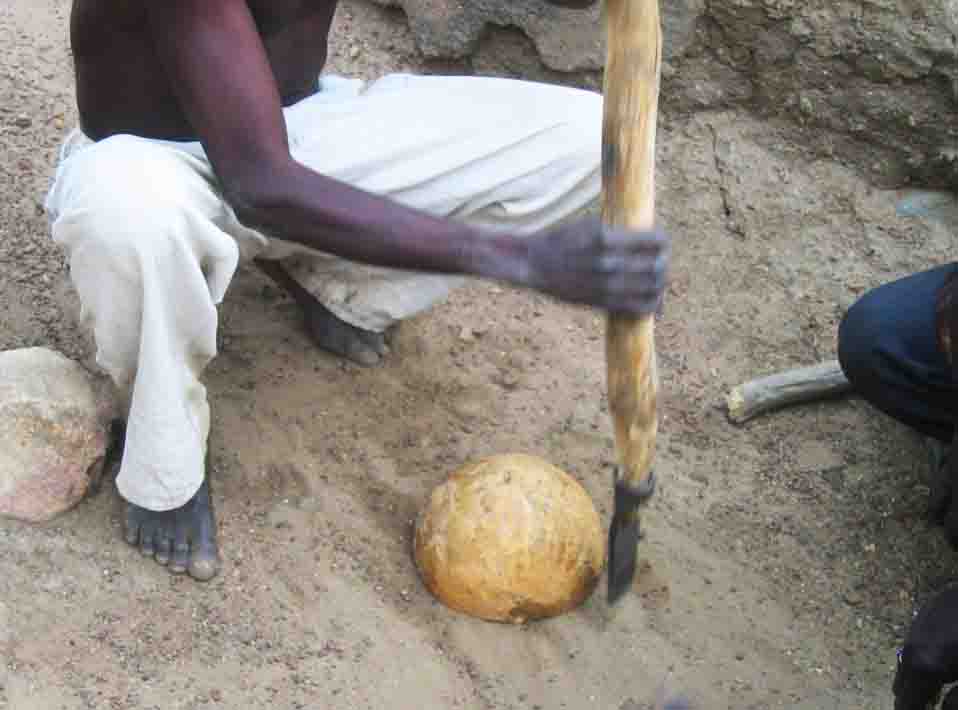 |
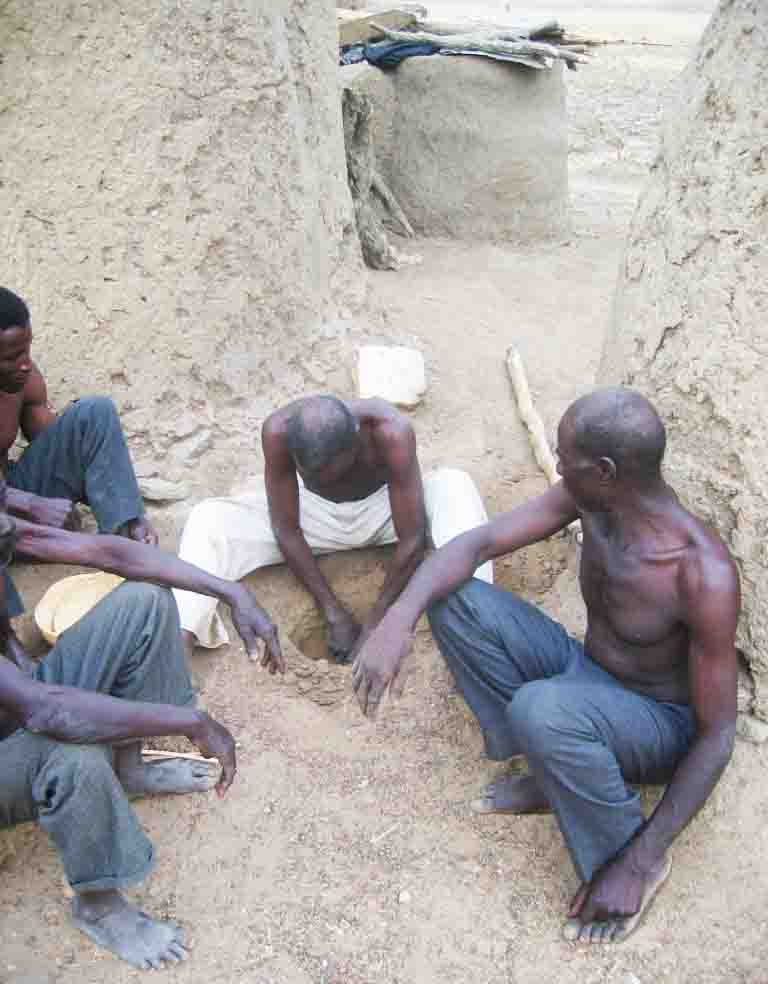 |
| Fig. 8 | Fig. 9 |
Immediately after forming the figure, the gravediggers started the preparations for digging the grave north of the compound entrance (nansiung). One of them placed a calabash on the chosen spot and, with his traditional spade (dachoruk), drew a circle around it at a distance of about 10 cm (Fig. 8). Then he threw a stone against the calabash three times, a ritual the sense of which could not be explained.
The first phase of the excavation was carried out with a hoe blade, a calabash bowl, the dachoruk spade and the gravediggers’ bare hands (Fig. 9). The depth of this mock grave, which was less than half a metre, did not reach that of a real grave (i.e. more than one metre). The shaft widened at its bottom into a circular grave chamber with a diametre of about 80 cm, which was used to accommodate the head and legs of the dead body. After it had grown dark, the work at the grave was performed by the light of traditional torches, i.e. burning single millet stalks (miena). After the digging was finished, the dachoruk (spade) was placed over the hole to demonstrate that no living being might enter the grave again (which, in any case, would be impossible due to the small proportions of the hole and the grave chamber).
Achaab, the head of the compound, had prepared millet water, groundnuts, a small bag of tobacco, a bottle of akpeteshi (distilled palm wine) and, later, also a fowl and a goat for sacrifices and as gifts for the gravediggers.
At 9 p.m. millet water was poured as a sacrifice (kaabka) in front of the grave1 and afterwards the gravediggers drank the rest. Before the chicken was sacrificed, the gravedigger moved it three times over the grave hole, killed it by knocking it against the dachoruk-spade and stepping on it with his bare feet (Fig. 10). In contrast to other sacrifices, this fowl was not allowed to flutter before dying. The first gravedigger opened three groundnuts and placed the seed on the ground near the grave together with a small portion of tobacco. A neighbour killed the goat which was immediately cut into pieces on a bundle of millet straw (Fig. 11). The remainder of the food and drink that had not been sacrificed was given to the gravediggers.
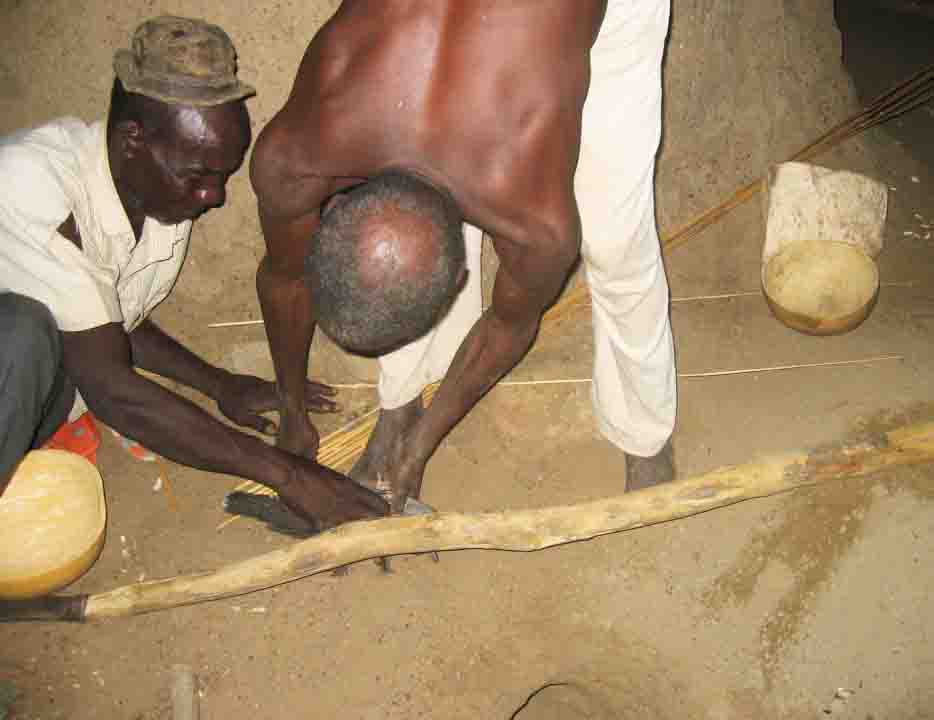 |
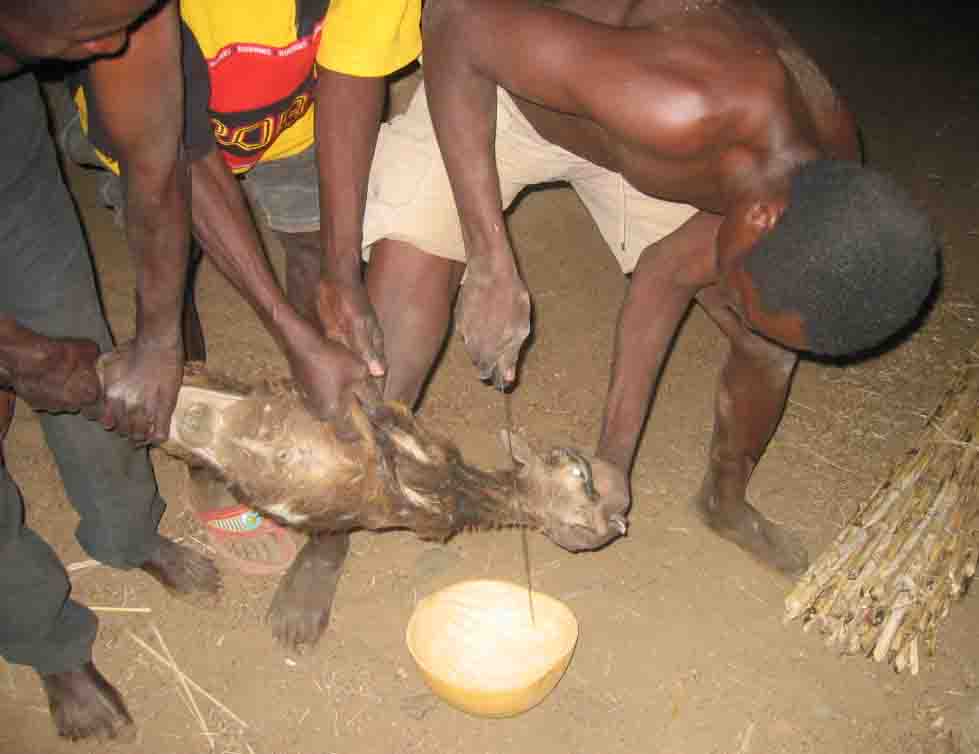 |
| Fig. 10 | Fig. 11 |
The ritual procedure could not go on in Achaab Yeri before they had not made up for two omissions at former burials. According to the lakori-principle (cf. Kröger 2012), rituals that have been performed in the past may be performed differently in the present, but the additions or changes have to be re-performed for the older recipients. Two members of Achaab’s sub-lineage had died some years before and had been buried without receiving the sacrifice of a goat. Therefore relatives of the deceased left Achaab Yeri with two goats which they killed over the graves of these two neighbours near their compound. A third goat was killed for some deceased people of Achaab Yeri, including a woman2 .
 |
| Fig. 12 |
When all were back in Achaab Yeri, the kpiak-gebika ritual was performed. I had heard about this ritual before, but none of my informants had ever seen it because it was top-secret and not even close family members are allowed to watch it. After two gravediggers had entered the dalong, the entrance was entirely closed by the death-mat (tiak). Then one of the two men inside opened it again and asked me to enter. Inside I was even allowed to take photos. One gravedigger took a fowl, removed the mat a little and a hand from outside grapped the other half of the fowl, which remained inside. Later I learnt that the man outside was Achaab, and his eyes had been closed for this ritual by another person’s hand. When the two men were holding the fowl, it was cut in two with a cutlass (Fig. 12). Through this ritual all of the conflicts and annoyances between the deceased and the survivors should be eliminated through the chicken taking over all of the guilt and then being killed for it. This ritual is secret because the souls of all living persons, especially of the deceased’s friends and relatives, are in danger of being enticed to follow the defunct to the realm of the dead if they see this ritual.
Later I discussed with my Bulsa friends why I, the stranger who had never before been in Achaab Yeri, was allowed to watch the ritual in the dalong. One or all of the following reasons might be applicable: I was a very good friend of the kpagi, the main officiant of the whole burial performance who had given his permission. I was also a good friend of the senior gravedigger who might have protested. My position as a complete stranger to the house might even have been of advantage since the deceased probably had no particular desire to demand my companionship in the realm of the dead.
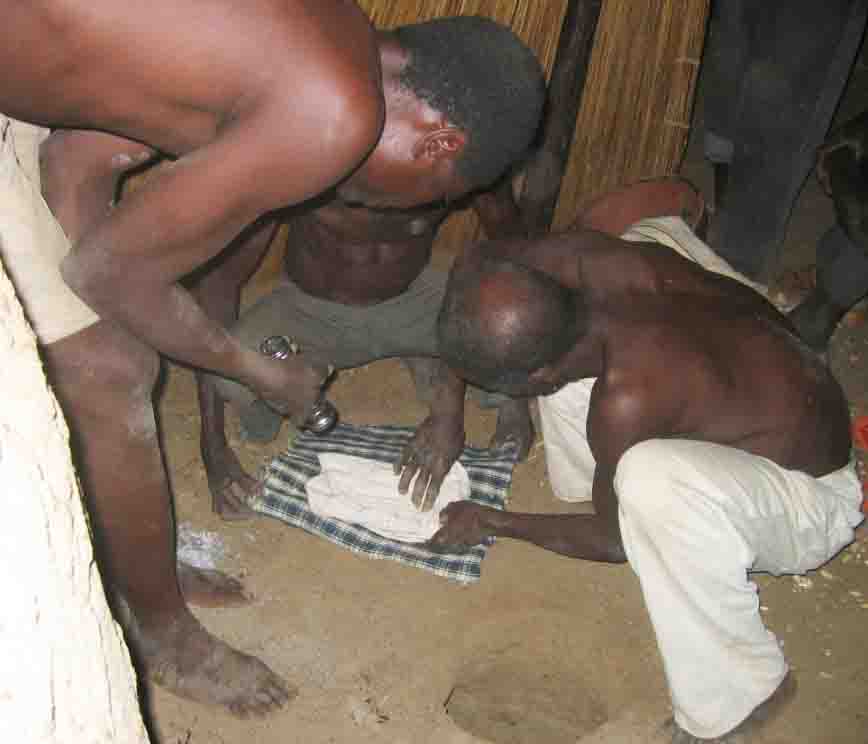 |
 |
| Fig. 13 | Fig. 14 |
After the ritual in the dalong the burial proper began. The death-mat containing the mud figure wrapped in a white cloth which functioned as the triangular Bulsa man’s underwear (Fig. 13), a wooden headrest (zukpaglik) carved by one of the neighbours and the blue-white cover cloth was carried to the grave. Here it was unrolled and set up in a vertical position around the grave. This is to shield the burial activities (which have an esoteric character) against any spectators except the gravediggers and close family members. Three gravediggers and I were inside the mat-fence. One older and experienced man stood outside the mat and occasionally gave some advice or instruction. The mud-figure in its white golung was placed in the grave.
Achaab was called to inspect the grave, give his consent to the work done and touch the dead “body” (here the wrapped-up mud figure). He threw three handfuls of earth into the digging shaft and added a big white smock (garuk, Fig. 14). The grave cover, a ceramic vessel (chari) was pierced (Fig. 15) so that the soul of the deceased can freely leave and re-enter the grave, e.g. for residing within the death mat. The cover was moved (yulim) three times over the grave in a circular way by Achaab before it was fixed over the shaft. The man outside of the mat fence objected to the way the white smock had been folded before being placed into the grave because it allowed the soul of a living person to hide in it and join the dead man. It was taken out, unfolded, folded again and returned into the grave.
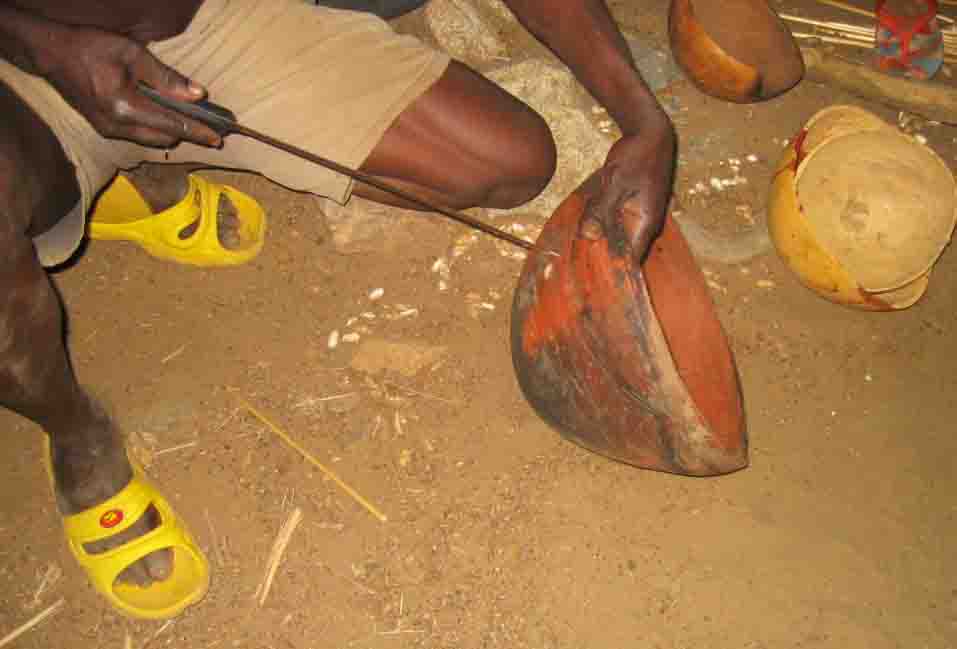 |
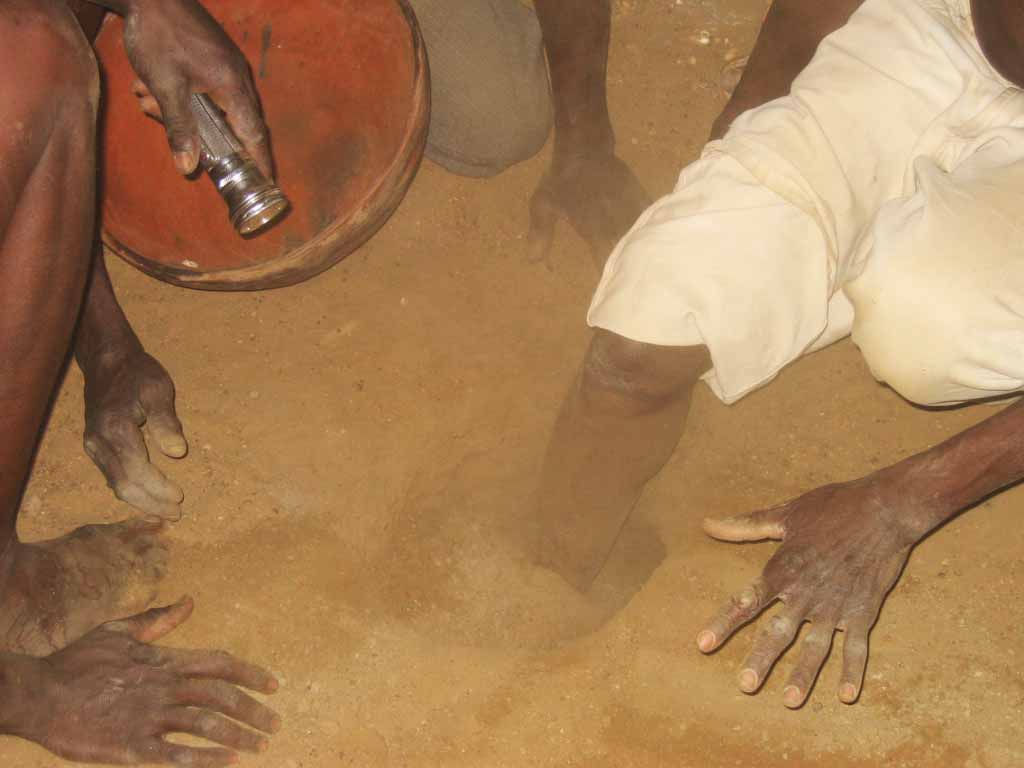 |
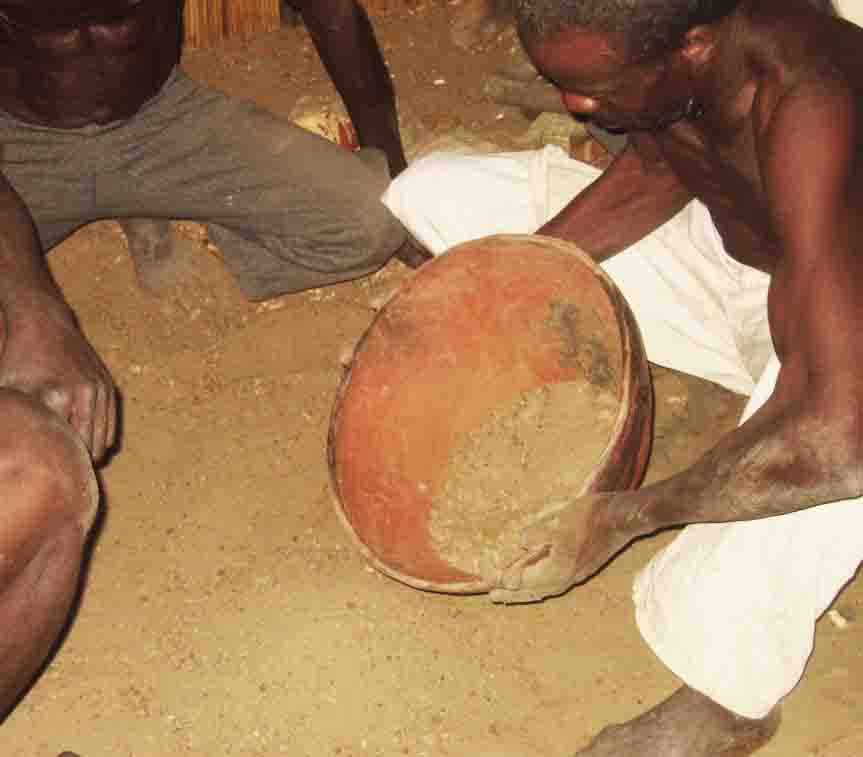 |
| Fig. 15 | Fig. 16 | Fig. 17 |
Before they started throwing earth into the grave, the first gravedigger put his foot in the grave in order to prevent earth from intruding into the ears and eyes of the “dead body” (Fig. 16). The earth in the grave was pressed with the upper end of the spade (dachoruk) to prevent the grave from sinking in later. The ceramic vessel (in this ritual context called boosuk) with some sand in it was placed on a small mound of earth on the grave (Fig. 17). The hole in the vessel, filled with a splinter of a millet stalk (ngmeena) to prevent earth or dirt from intruding into it, had to be placed facing the east. One gravedigger sprinkled water on the vessel, plastered it with wet mud and drew a cross in the wet plaster with one of his fingers (here not regarded as a Christian symbol!). Washing their hands (as part of the ritual) and placing the long handle of the spade (dachoruk) and the calabash used for sprinkling water beside the grave finished the gravediggers’ activities at the grave. The blade of the spade was kept at the main entrance (nansiung) of the compound and the mat with a blue cover cloth around it was placed in the courtyard (dabiak) in front of the ancestors’ room (dalong). Its thinner end was on the ground, a placement that is strictly forbidden for mats without a ritual context. It is now no longer called tiak (sleeping mat) but ta-pili (rolled up mat).
Ta-pili yika (Hanging up the Mat) and Nyiinika (Smoking)
Three days after the burial the ritual of “hanging up the mat” (ta-pili yika) took place in the late afternoon, as it is the general custom among the Bulsa. While the mud figure represented the deceased man during the burial activities, it was now the mat, dressed in the blue-white cloth, which symbolized the dead person. The destination of all condolence visits was and will be the mat and not the grave.
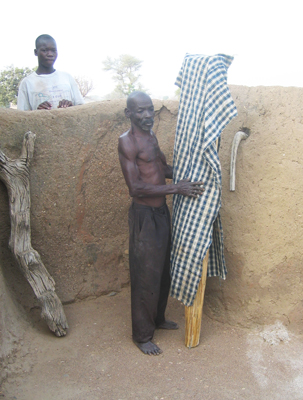 |
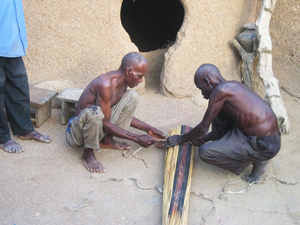 |
 |
| Fig. 18 | Fig. 19 | Fig. 20 |
After the obligatory speeches in the kusung, two bare-chested gravediggers took the rolled-up mat, which had been standing in the inner courtyard (Fig. 18) in front of the ancestors’ room (dalong) for the preceding three days. The gravediggers prepared the mat, which contained the wooden headrest (zukpaglik), for the “hanging up” by wrapping untwisted fibre around it (Fig. 19). Achaab, the head of the compound, was only a spectator without any functions at this ritual. The gravediggers carried the mat into the dalong and fixed it under the roof beside the mat of another deceased person of the compound (Fig. 20). The fibre strings will perhaps later be replaced by nylon string or wires to make them termite-proof. During the funeral celebrations, which sometimes take place only years after the burial, these mats will be used for various rituals and will finally be burnt on a field outside of the compound.
After the ta-pili yika ritual, the gravediggers went to a place near the entrance of the compound and started a fire in a bowl (kpalabik) for smoking (nyiini) things that had been used during the burial and still contained the smell (piisim) of the “corpse” (i.e. the mud figure). I forgot to ask what was actually burnt, but on a similar occasion in another compound the fuel consisted of dried chicken faeces and ngmanyak-grass. The objects were cleaned by holding them in the smoke. These objects included, for example, the blue-white cover cloth of the mat (Fig. 21), a ceramic vessel (liik) which had contained water for mixing the plaster of the grave-cover, a calabash bowl (chin) and the hoe blade that had been used for digging the grave. After cleansing them with smoke, all of these things could be used for secular purposes again. The long handle of the spade (dachoruk) and one calabash, both of which were still lying on the grave, were not included in this procedure.
In order to announce the conclusion of all the burial rituals, Achaab’s son fired some shots in front of the compound not by using an old muzzle-loader but the specific Bulsa instrument called da-goong (Fig. 22) which consists of an iron tube with an ignition hole at one side (about its function cf. Kröger 2001: 653-54).
 |
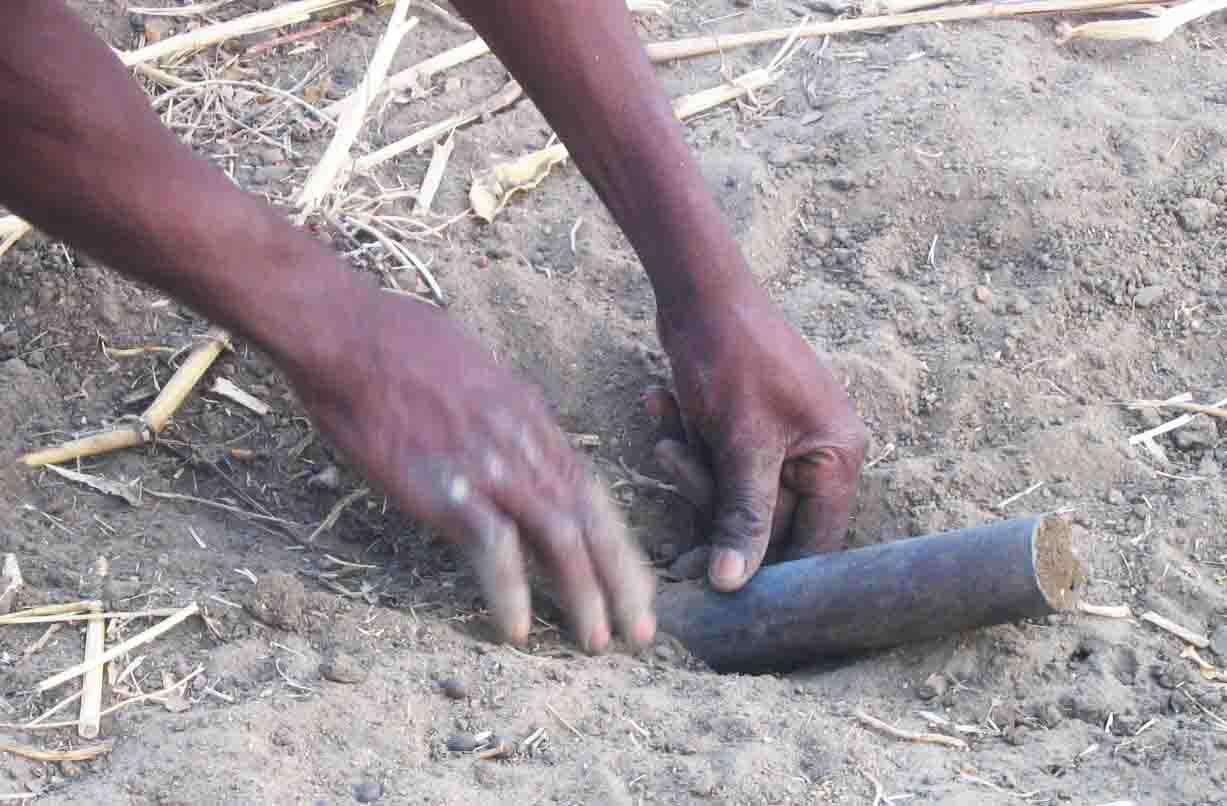 |
| Fig. 21 | Fig. 22 |
Comparison with Ordinary Burials
It is worth noting that the ngarika-burial resembles an ordinary burial to a very high degree. Of course all activities concerning the dead body as such are not performed or are greatly reduced. These activities include, for example, the confirmation of death, washing the corpse, shaving his/her hair and massaging the dead body to delay rigor mortis (thus enabling the corpse to pass through the narrow grave shaft and be positioned in the small grave chamber). Some of the other rituals are altered slightly. The noai-boka of a person who died in the compound can also be performed in the cattle-yard (nangkpieng) of the compound. In the kpiak-gebika ritual, it is usually the person who had some conflict with the deceased who is holding one end of the chicken while here Achaab probably represented all (living and dead?) inhabitants of his compound. It is surprising that the activity of digging the grave with all of its small rituals is nearly identical in the two burial variations. These similarities include:
• screening the area by means of the death mat,
• throwing small stones against the calabash,
• piercing the ceramic grave cover (boosuk) with a hole
• circling the boosuk before placing it on the grave with the hole directed to the east (for men),
• inspection of the grave by the compound head and/or his eldest son when their work is nearly finished,
• all of the details of the ta-pili yika rituals three days after the burial,
• smoking the objects that had some contact with the corpse.
It is worth mentioning that in Achaab Yeri one gravedigger even tried to avoid earth intruding into the corpse’s ears by placing his leg in the grave since the procedures followed during an ordinary burial cannot be applied here (e.g. putting the hands of the deceased or hoe blades on his ears). Also the smoking of certain objects does not make much sense since the mud figure doesn’t emit any smell (piisim).
The cause for not leaving out a ritual which does not make any sense in the ngarika burial may be rooted in the deep feelings of respect for tradition as well as in the fear that discriminating against the person who died in a foreign place might provoke his anger and thus endanger the living people.
Ngarika-Burials in Modern Times
There have always cases where Bulsa have died outside their traditional area. In pre-colonial times, when Babatu the slave raider haunted parts of Northern Ghana, many Bulsa were abducted, and their relatives never heard from them again. The (ngarika-) burials and final funeral rites for some of them have been performed in the meantime, while others are still pending.
In colonial times many Bulsa were recruited for the Gold Coast Regiment, and some of them even died in Europe during the First World War. To earn some of the British money that had been introduced by the colonial power, Bulsa walked (!) to Kumasi and other towns for the opportunity to work in one of the cocoa plantations.
After Independence in 1957, it was the magnetic attraction of the big towns in Southern Ghana that moved young men to leave their native villages and look for job opportunities or to start a life of hard work in one of the gold mines (e.g. in Obuasi). In quite modern times countries in Europe or North America became attractive, particularly among the educated Bulsa youth. A great deal of these migrants were looking forward to returning to Buluk as rich and respectable men or women. Others, perhaps married to European or American partners, became so assimilated into their new culture and its prosperous life that they gave up all plans of returning home for good.
All these people were faced with the question of what would happen to their body after death. Very rich Bulsa uttered in their last will that their body should be transported in a coffin by aeroplane in order to be buried near their father’s compound within a more or less traditional ritual framework. Other less wealthy Bulsa knew that when they died, their sons could not afford these high transport costs and instead requested that their sons go home to the traditional Bulsa areas with a piece of cloth containing the body-dirt (daung) and a handful of mud from their father’s foreign grave which would be used to perform the ngarika-burial. Again others were content only to be buried in the foreign country.
A new influence on the performance of burials was exerted by Christianity and - to a lesser extent - Islam (cf. Atuick 2013: 36-42). Devout Christians usually wish to be buried with the ceremonies of their own new religion, and this not only holds for deaths abroad but also for Bulsa villages. For people in such a situation, the double burial is apparently on the rise. A few days after the Christian burial at a cemetery, a ngarika is performed with a cloth and the mud from the grave. Even for non-Christians and non-Moslems who die in a hospital (e.g. in Sandema), it may be inevitable that he or she is buried near the hospital and the relatives must be content with the performance of the ngarika.
Although the number of deaths outside Buluk will probably increase, it is not certain whether the quality of the ngarika will suffer changes. Many of the rituals which no longer make sense for a burial without a corpse (e.g. preventing mud from intruding into the ears of a mud figure or smoking objects to remove their piisim-smell) may be dropped. For Christians the ngarika may possibly become only an old custom with a folkloristic character. The idea that the ritual is necessary for a happy afterlife in the company of ancestors may no longer be of any value.
References
Franz Kröger
1992: Buli-English Dictionary. With an Introduction into Buli Grammar and an Index English-Buli. Lit Verlag Münster und Hamburg (572 S.).
—, 2001: Materielle Kultur und traditionelles Handwerk bei den Bulsa (Nordghana). Forschungen zu Sprachen und Kulturen Afrikas (Hg. R. Schott), 2 Bände, Lit-Verlag, Münster und Hamburg.
--- 2012 Die dauerhafte Etablierung von rituellen Abweichungen. Das lakori-Prinzip bei den Bulsa Nordghanas. Anthropos 107: 1-12.
Atuick, Evans Akangyelewon
2013 Are Final Funeral Rites in Buluk Really Expensive? Buluk - Journal of Bulsa Culture and History. No. 7: 36-42.
Endnotes
1. In Buli, the language of the Bulsa, the verb kaabi (to sacrifice) is used for these offerings at the grave, but my informants agree that libations or killing animals for the dead person are not real ancestral sacrifices because the deceased will hold the full status of an ancestor only after the second funeral celebration (juka).
2. The omission of my participation in these "sacrifices" was not due to a prohibition on the part of my hosts, but to my having fallen asleep after a short rest in the kusung.
3. I forgot to ask whether this was the white cloth of the footpath or whether they had replaced it by a small white golung. Bulsa smocks and golung-underwear are offered on Bulsa markets in miniature sizes. My first idea that they are jokingly worn by small babies was wrong. They are exclusively used for funeral purposes.